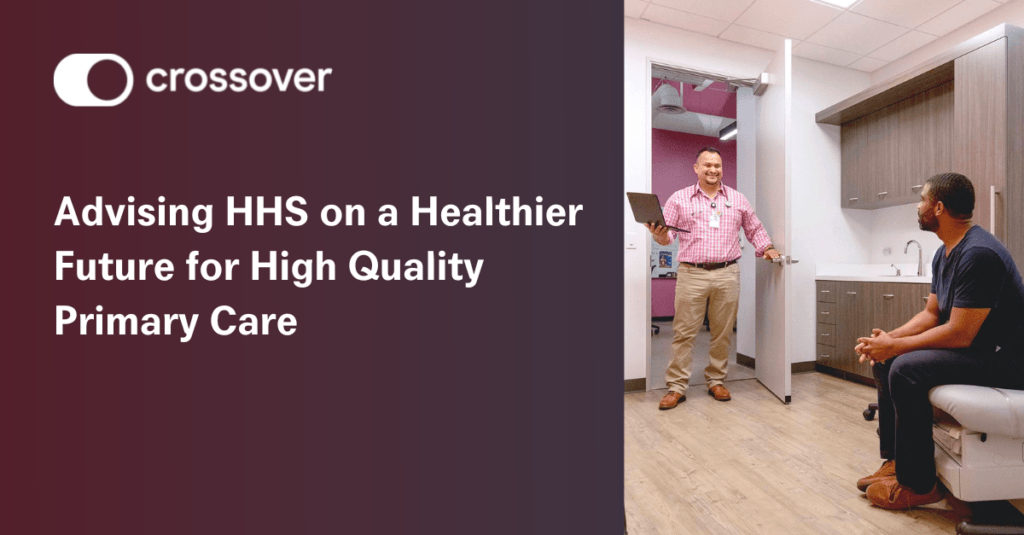
Blog
Crossover Health’s Response to the HHS RFI to Strengthen Primary Health Care
By Joel Haugen
Fact: Primary care is the only component of healthcare where an increase in supply is associated with better population health and more equitable outcomes.
Also fact: Our nation’s primary health care foundation is weakening and in need of support.
Chronic underfunding and under appreciation of primary care combined with a misaligned focus towards fee-for-service-payment models are wreaking havoc on costs and health outcomes. But organizations like Crossover have been working tirelessly to change this reality and implement high quality primary care despite the many obstacles we face.
So, when The U.S. Department of Health and Human Services (HHS) announced a public Request for Information (RFI) to aid in developing an initial Action Plan as part of their initiative Strengthen Primary Health Care, we at Crossover jumped at the opportunity to the contribute to federal foundation for the provision of primary health care.
Following are key findings, observations, strategies and prioritized actions we at Crossover recommended to the HHS to build a federal foundation for strong, accessible primary care.
I. What’s Working: The Models and Innovations that are Advancing Primary Health Care
The good news is that implementing high quality primary care is possible. Crossover has been doing it for over a decade.
The secret to our industry-leading outcomes is our care model. We’ve designed our Advanced Primary Health care model based on everything we know as physicians and healthcare innovators to be true about implementing high quality primary care, including:
- trusted relationships,
- an interprofessional care team approach,
- a biopsychosocial care foundation,
- and a value-based payment structure.
These key elements enable us to deliver high quality care and a great experience to members while producing consistent cost savings and better resource utilization. The following is a small sample of the results of our care model, based on careful analysis of our member population:
- Better access: Members wait on average 1 day for a primary care appointment (vs. 19.5 for comparable community providers) and can choose to access their team virtually, in person, or both, in addition to asynchronous communication between visits.
- Better health outcomes: Crossover members have high rates of care gap closure (up to 53%), achieve a 52% reduction in mental health severity, and receive less unnecessary care).
- Lower Costs: Crossover achieves up to 15% reduction in Total Cost of Care, rising further for more engaged member segments.
- Better Engagement and Therapeutic Alliance. 81% of Crossover members consider us their medical home, or the first place they go for care.
II. Current Barriers to Strengthening Primary Health Care
There are many barriers that organizations like Crossover encounter when trying to scale high-quality primary care across the broader commercial population, specifically:
- The existing commercial insurance system fee–for-service infrastructure. Consequently, payers are often not technically able to support alternative payment models such as fixed fee payments or struggle to embrace newer models of payment in the commercial populations.
- The cost and regulatory burden to become licensed as a risk-bearing entity by state insurance regulators. These can be extremely prohibitive for most individual provider organizations, who do not have the resources of large payers or health systems.
III. How the HHS Can Make the Biggest Impact
Following are key strategies and prioritized actions we at Crossover recommended to the HHS to build a federal foundation for strong, accessible primary care.
- First, we believe that the biggest impact HHS can have within the current legislation and funding environment is to increase the prevalence of payment models in Medicare that promote the delivery of high-quality primary care; in particular, those models that utilize a fixed-fee payment. Increasing the prevalence of these models will strengthen the incentive for commercial payers to build the technology and infrastructure to support them.
- Second, we believe HHS could also support an increase in the overall portion of spending going to primary care services. As the overall portion of spending available for primary care increases, payers will be more likely to allocate the funds needed for innovative, high-quality primary care models to flourish.
- Third, individual states can have a direct impact on the commercial insurance space, sometimes in ways that HHS cannot. We believe that HHS can encourage and work with states to ease or clarify the regulatory barriers placed on providers looking to take on risk as part of their delivery of high-quality primary care.
It is gratifying to see government agencies and entities acknowledging the broken system of primary healthcare today and take efforts to evolve primary care from its current state to reflect “health as it should be.” It’s even more gratifying to have the opportunity to contribute after years of innovating in this challenging space.
___
About the Author

As Chief Product at Crossover Health, Joel Haugen is responsible for developing and executing the strategic product roadmap, including scaling the solutions portfolio from design and tech enablement to delivery and optimization. Joel’s expertise in product strategy is seen in his long history of successful large scale system implementations during his 15-year tenure at Optum, with significant experience in aligning client needs with the right solutions across the provider and payer markets.